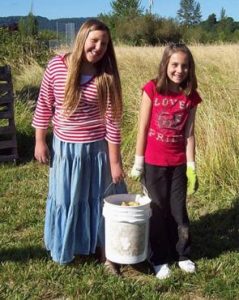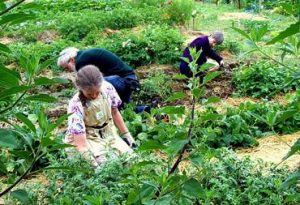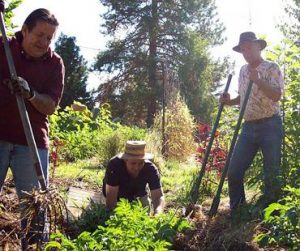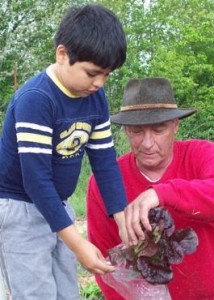By Llyn Peabody
A Sharing Garden differs from the usual community garden in that it is one large plot, shared by all, instead of many separate ones rented by individuals. All materials and labor are donated. The food we grow is shared amongst those who have need, whether or not they have contributed time, materials, or labor. All surplus is donated to our local food bank and other charities. No one is ever charged money for the food that is grown. This model is easily replicated anywhere there are vacant lots and people with enough gardening experience to oversee the project, and does not require a large input of money to make it work. It can also be adapted to many different scales of gardening, from a few families who live and garden on the same block to a multi-acre production farm.
My husband Chris Burns and I started the first Sharing Garden in the small rural town of Alpine, Oregon, in April of 2009. Located about midway between Corvallis and Eugene, Alpine is a “blink and you miss it” town; the only commercial establishment, a small tavern. The garden is 100 ft. by 80 ft. and was established on a converted lawn, in a park that was created by local residents in the 1960s. Chris and I used to take daily walks through the park and were dismayed by the vandalism to the park’s picnic pavilion and benches. There was little sense of coherent community in the town and we wanted to grow more food than was possible in our tiny home-plot where we were renters. So we approached the committee that oversees the park, and a local nonprofit agency to see if they would become our fiscal agent and, with very little effort or resistance, the Alpine Sharing Garden was born.
That first year, we created and maintained the gardens mostly by ourselves. Volunteers did help on occasion—farmers with big equipment tilled the soil and dug fence post holes; sometimes we had help with planting, weeding, and mulching. But we didn’t make an effort to recruit much help as it was easier to work alone, developing our systems and techniques (our relationship was only 18 months old and, though Chris has over 40 years of gardening experience, I was coming to it new). Had we had the complexity of adding other people’s energy and input into the project at that time, it might have been a bit chaotic or overwhelming, leaving everyone frustrated with the experience.
That spring, we moved from a two-bedroom house, where we paid $750/month in rent, to a 1950s, park-model (plumbing hooked up to septic), 8 ft. by 40 ft. travel trailer. With work exchange of just 20 hours/month and $50 for utilities, we were able to greatly reduce our expenses. June of 2009 is when gas prices and unemployment began to rise sharply. Paying work, in our rural valley, became very hard to come by. Chris and I had some savings to carry us for a little while, and with the $1,250 we raised for the gardens through donations, we were able to devote our full-time energy to growing the garden and developing the model. By mid-summer we were harvesting our first fresh vegetables, with enough surplus to take a wheelbarrow full to the food bank each week, and were able to inspire other local gardeners to begin donating their surplus there as well.
In year two (2010), things began to grow exponentially. Chris noticed an empty lot behind the local food bank. We approached the owner of the property about starting a second garden, and, without a moment’s hesitation, he cast his full support behind the project, paying for a new pump to be put in the well and covering the cost of the electricity to run it. We have a year-to-year agreement with him and he lets us use the land for free. The only caveat is that he has the property for sale and, if it sells, we will only be able to garden until the end of the season, at which point we will have to find a new site.
This second Sharing Garden is located about five miles from Alpine in the town of Monroe. Though still quite small (population 680), Monroe has a dozen or so businesses, the local high school and grade school (within sight of the Sharing Garden), a city council and mayor. With its proximity to the food bank, we are able to literally wheelbarrow the just-picked vegetables straight to our main recipients. Kids walk by the gardens on their way home from school and often visit with us and help us to grow food which they happily take home to share with their families.
In 2010 we began to grow the volunteer program in earnest. We established regular volunteer times at both garden sites and created an email list of interested people so we could remind them weekly of where and when we’d be meeting. Though we had over 20 people on our list, our core group numbered more like five to eight. These were the people who came week after week to participate in the fun and camaraderie that began to develop.
Some of my best memories of that year were on harvest days. We’d get started in the cool of the morning, empty harvest boxes piled by the gate, with the sound of bird calls, and a light mist and dew hovering on the garden. Volunteers would arrive and Chris would direct them to areas ready for harvest. Some people liked to pair up in the bean patch, slowly moving down the rows, comfortably scooting along on the thick, dry straw we mulch the paths with. Bean picking is most conducive to conversation and you could hear the murmur of people catching up on their lives, occasionally punctuated by laughter as they filled buckets and boxes with beans.
Tomato picking is for people who like the hunt. We had about 200 plants in the Monroe garden! No time to build cages that year so the vines sprawled on a bed of straw and pickers had to crawl between them to find their precious fruit. We did a pre-sort right there in the field: ripe tomatoes that had begun to split were boxed separately to be taken home and canned. (For many volunteers this was their first experience at canning and preserving food, inspired by the cornucopia of fresh produce.) As the boxes and buckets were filled, volunteers brought them to the weigher/record-keeper who kept track of the harvest. After it was recorded, it was brought to the food bank about 50 yards away, and made available to the 30-50 families/per week (up to 200/month) who receive support.
There is a beautiful “hum” in the gardens on harvest days. I think this comes from the fact that people know they are doing meaningful service. Food is such a fundamental need—truly “common ground.” The Earth gives to us freely—no price tag on the sun, the air, soil, or water. When we are able to participate in this “gift economy,” giving without thought of receiving, I believe it touches something ancient and true and feeds us far beyond the nutrients and calories we receive from the food itself.
One of our greatest problems in 2010 was what to do with the tremendous surplus we grew! At the end of the food bank session, Chris and I would stand with literally boxes of beans, tomatoes, squash, and cucumbers, encouraging volunteers and food bank stragglers to “Please, take more home!” We grew and gave away about 5,000 pounds of vegetables, including 270 bunches of kale and heads of lettuce (a local market value of approximately $9,950). In 2011, we established a connection with a second food bank and a bi-weekly lunch program for seniors to pick up our surplus produce each week and distribute to other people in need, thereby eliminating this problem.
I think one of the concerns that comes up for people when they consider starting any project that involves sharing (especially without a specific system of accounting), whether it’s in a garden, or creating a tool bank, etc., is “Will I get enough? Will my needs be met? Will it feel fair?” In terms of gardening, perhaps you have a favorite vegetable, or you want to preserve some of the harvest and want to have enough at any one time to make your canning project worthwhile. Here is how we address these concerns: We have focused on growing foods that are popular, rather than growing specialty items that will be unfamiliar to the average food bank recipient or garden volunteer. We also devote a considerable amount of garden space to growing storage crops such as potatoes and winter squash so the gardens continue to feed people through the winter. But we also have started smaller patches of less familiar vegetables: arugula, tomatillos, and fava beans, to name a few. These satisfy the pallet of our more sophisticated recipients and help expose others to new taste sensations. As for having enough to preserve, this has varied significantly in our two main harvest years: 2010 and 2011. When we have had enough surplus, the volunteers took home copious amounts for their own home canning.
Another “fairness” issue that we have had to face involves how much time each person volunteers: “If I helped in the garden twice as much as the other guy, how come he’s taking home the same amount of produce?” Our model is meant to help people develop the practice of giving without thought of return; without specifically accounting in a buy/sell or even bartering state of mind. We encourage volunteers to “give what they can” and “receive what they need.” It is interesting to me that the volunteers always seem concerned that they are taking too much. It is the people who are receiving the food for free at the food bank who sometimes get into a “hoarder” mentality. Through his 14+ years of communal living, sharing “all things common,” Chris has had first-hand experience of the tremendous prosperity, health, and well-being that is possible through this kind of model. And while the Sharing Gardens are only a small-scale effort to re-infect our culture with this beneficial concept, we see evidence with most people our project touches that the seed of sharing lies dormant in us all and needs only a bit of nurturing for it to bloom and bear fruit.
Many community gardens of the standard variety run into problems of stealing and vandalism. They have to put high fences around their gardens and a lock on the gate so that they can be sure to reap the harvest from their efforts. Any time you have a situation of “haves” and “have-nots,” it can set up a dynamic conducive to theft. Growing enough to share, while making it easily available, seems to diffuse this potential problem. Stealing and vandalism have not been issues for us. Our presence in Alpine’s park seems to have eliminated the vandalism they were experiencing before we came. Our gardens grow such an abundance of food that there is plenty to share. In fact, each garden has a rural-style mailbox at the gate, with a harvest knife and clean, recycled plastic bags for people to harvest the bounty. So far, no one has ever taken advantage of the gardens’ generosity.
Our project gives a new definition to the term “community garden.” Likewise, we see it offering a new model of “community-supported agriculture” (CSA). The typical CSA is a small-scale farm, local to the city that it serves, providing a subscription to fresh, organic produce. While some CSAs offer the opportunity for subscribers to assist in the growing of their own food, this is not the norm. Nor do they have a full-circle, reciprocal relationship with their participants, where surplus or “waste” materials from the city-folk are channeled back to the farms that feed them. The Sharing Gardens are truly “community-supported” agriculture. Donations of time and materials come directly from those who will benefit from the harvest. Without the community support, the gardens will not thrive. While many progressive towns and cities have curbside pick-up for kitchen scraps and yard waste, most do not. Sharing Gardens provide a local place for people to bring their organic material. Lumber, fencing, and other building materials can always find new life in a Sharing Garden—also an outlet for empty five-gallon buckets, pots and flats (not recyclable in most places), and other household waste, most likely to go to the landfill.
Another term that we are redefining is “eating local.” It is important to look closely at what this means for all aspects of food production, not just the shipment of food (a modest fraction of the total food “footprint”). Farming, as it is practiced even by small-scale, organic farmers, often requires large inputs of fertilizers that must be shipped long distances, and the purchase of seeds developed by seed companies in entirely different bioregions. The extraction and processing of many soil amendments can take a real toll on the environment. Seaweed, dolomite, and other sources of minerals are not readily available to many farming areas. Blood and bone meal, while providing an outlet for these byproducts of the dairy and beef industries (thus reducing waste), are also not necessarily a local resource and, for the vegetarians among us, their use can be distasteful. The Sharing Gardens use a deep-mulching method of gardening. (We added approximately 10 tons of hay, straw, leaves, and grass clippings to the half-acre we had in cultivation in 2010.) The mulch provides tremendous habitat for worms, fungi, bacteria, and other beneficial organisms—our “micro-livestock”—to establish a healthy ecosystem conducive to growing vibrant, abundant produce. The worm castings and other byproducts of their life-cycles fertilize and contribute to the tilth of the soil in profound ways. Each year we have significantly reduced our use of commercial fertilizer and manure from “macro-livestock” (cows, rabbits, etc.) to model a method of growing food that is more truly local at all levels of production.
Another way we are “localizing” is by saving our own seeds and participating in seed swaps with other local gardeners. This has reduced our dependence on commercial seed producers, thus insuring we can always plant next year’s garden, should supply chains falter. Over time, saving seed also develops strains that are better suited to one’s micro-climate; day length, temperatures, and rainfall.
My husband Chris and I envision a world where sharing is the norm; a world beyond buying and selling and private ownership. We would like to see a healthy balance return in our relationship with the natural world and our sisters and brothers in the human and non-human families; everyone having their basic needs met and plenty of time for creative expression, exploration, and deepening union with the great mystery that is the source of all life. We share a deep desire to live in community; to live with others of like mind, sharing “all things common.” For a while we felt disheartened because we couldn’t find others who wanted to live as we do. The Sharing Gardens, though not the same as living in residential community, do provide an ongoing experience of the joys and power of sharing and have the added benefit of exposing our ideals and perspective to a broad audience. Instead of being isolated in our own utopia, we are bringing a taste of these ideals right into the mainstream.
They say that the definition of insanity is to keep doing the same thing expecting different results. Metaphorically speaking, we humans keep rebuilding our homes and businesses in the flood plains of life. We are trying to solve the problems at the same level they were created which, as Einstein asserts, will not work! A thriving permanent culture cannot be built using the established models based on greed, profit, and putting personal needs first. An economy based on growth is not sustainable because nature, upon which all life depends, runs in cycles. Indefinite growth is another name for cancer. It may seem naive but we feel that the only viable way out of the crises we are facing is to abandon the old model of private ownership and shift to a model of sharing. As long as we continue to harbor vestiges of the old system, we give a basis for the cancer to reestablish itself.
Though our gardens are only one branch on the vine of the human food system, we feel hopeful from our experience. We are helping people add new dimensions to the concepts and practices of the Permaculture, Transition Town, and Sustainability movements. And, beyond the specific skills gained through participating in the Sharing Gardens, we are building lasting friendships and creating a more resilient network amongst people that can be called upon as new economic and environmental crises inevitably present themselves.
To find out about our vision for community based on the principles of unity and radical sharing, search for the Full Circle Family Church in the online Communities Directory at www.ic.org. To find out more about the Sharing Gardens, follow the link from that listing.
BENEFITS OF A SHARING GARDEN
Growing the food in one large plot, instead of separately rented plots (as in most community gardens), has many benefits:
Sharing Gardens:
Water more efficiently: Plants can be grouped together with similar watering requirements and placed so shorter plants are not blocked from receiving water.
Grow the maximum amount of food: With fewer pathways between garden rows, and greater flexibility for plant placement and rotation, the garden can be grown more efficiently.
Manage weeds and pests more easily: In a typical community garden setting, the lack of weed and pest-management in one plot can lead to the spread of offending bugs and weed seeds. In a Sharing Garden, if pests/weeds appear, they can be managed cooperatively and more efficiently.
Save pure seeds: Many plants will “cross,” or hybridize. This means that, in a typical community garden, neighboring gardeners would need to coordinate to keep their seedstocks pure. In a Sharing Garden, you can plan your crops to keep strains from crossing and save enough seed to last for a few years, at which point you can replenish your stock.
Keep materials out of the landfill: In our gardens, we use salvaged and recycled material whenever possible. This keeps these materials out of burn piles and the landfill while providing new life for tools and building supplies. Leaves, grass clippings, and other organic material contribute to the fertility of the soil instead of being burned or filling up landfill space.
Build community: Though some community gardens have regular work parties and social gatherings, the emphasis is on each gardener doing his or her own thing. In a Sharing Garden, the focus is on cooperation and sharing a common goal. Having a meaningful shared purpose builds great camaraderie and relationships that can be called on in times of crisis.
Excerpted from the Winter 2011 edition of Communities (#153), “Permaculture.”




